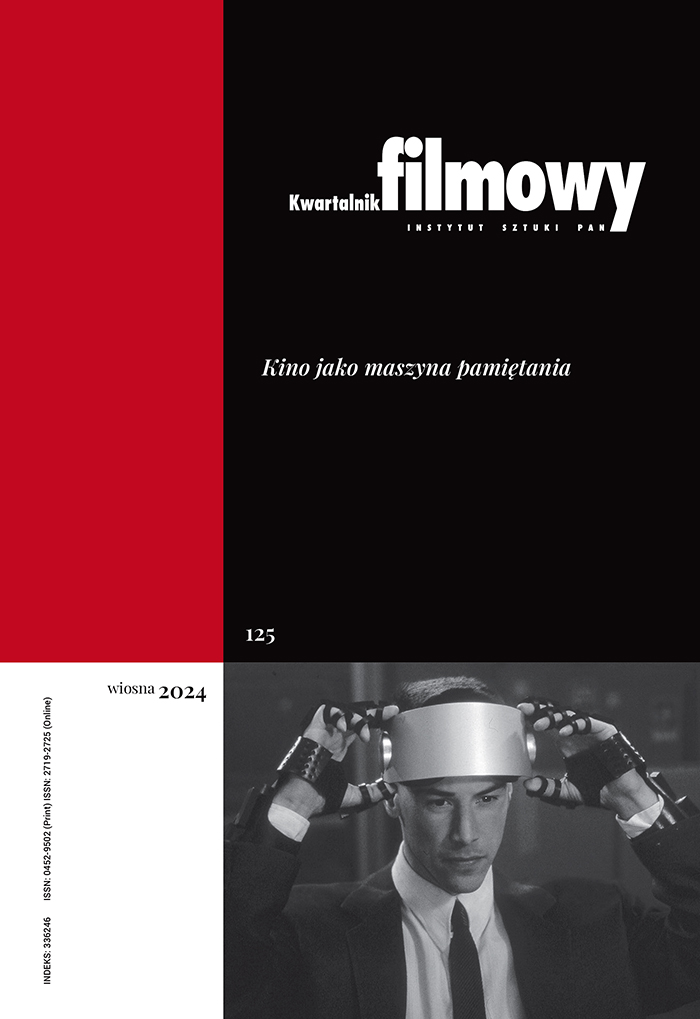On the Impossibility of Believing in the Documentary: Dariusz Jabłoński’s “Photographer”
Abstract
Colour slides of the Łódź Ghetto were found in Vienna in 1987. They were taken by Walter Genewein, the Austrian chief accountant of the Ghetto. In 1998, Dariusz Jabłoński made use of the story of Genewein and his slides to shoot the documentary film Photographer. Jabłoński juxtaposed two realities: the world of a smoothly operating enterprise portrayed by the Austrian and the reality recalled by Arnold Mostowicz, the Jew and one of the few Ghetto survivors. As Genewein and Mostowicz tell two different stories their views have to differ as well. Hence, Mostowicz’s disagreement with the reality documented by Genewein and the belief that it is a distorted picture which by no means corresponds with the remembrance of the place. Łysak tries to unravel the mystery of the points of view and understand the truth of the two sides. He also tries to take a closer look at the notion of a “documentary” and explore its possibilities as an objective record of reality. Łysak tries to analyse clichés of the pictures connected with the remembrance of the Holocaust (e.g., image of the gate of the Auschwitz camp with the inscription Arbeit macht frei) and the mechanisms governing a destruction of the clichés and habits (colour used in the portrayal of the Holocaust on the slides taken by Genewein). [originally published in Polish in Kwartalnik Filmowy 2003, no. 43, pp. 66-76]
Keywords:
Dariusz Jabłoński, Lodz Ghetto, HolocaustReferences
Alt, Dirk. 2011. „Front in Farbe”: Color Cinematography for the Nazi Newsreel, 1941-1945. “Historical Journal of Film, Radio and Television”. Vol. 31. No 1
DOI: https://doi.org/10.1080/01439685.2011.552680
Google Scholar
Baer, Ulrich. 2002. Revision, Animation, Rescue: Color Photographs from the Łódź Ghetto and Dariusz Jablonski’s “Fotoamator”. W: Spectral Evidence. The Photography of Trauma. Cambridge, MA
Google Scholar
Bordwell, David and Kristin Thompson. 2012. Film Art: An Introduction. McGraw-Hill.
Google Scholar
Struk, Janina. 2004. Photographing the Holocaust: Interpretations of the Evidence. London
Google Scholar
Authors
Tomasz Łysakkwartalnik.filmowy@ispan.pl
University of Warsaw Poland
Doctor of the Humanities, Assistant Professor at the University of Warsaw, graduate of the Graduate School for Social Research at the Institute of Philosophy and Sociology of the Polish Academy of Sciences (Warsaw). His papers were published i.a. in Literatura na Świecie, American Studies, Teksty Drugie, Kwartalnik Filmowy, Polin: Studies in Polish Jewry, Obieg and in collective volumes. He taught at the University of Washington in Seattle and at the University of Chicago, and held a Mellon Foundation Scholarship at the University of Edinburgh.
Statistics
Abstract views: 308PDF downloads: 300
License
Copyright (c) 2013 Tomasz Łysak

This work is licensed under a Creative Commons Attribution 4.0 International License.
The author grants the publisher a royalty-free non-exclusive licence (CC BY 4.0) to use the article in Kwartalnik Filmowy, retains full copyright, and agrees to identify the work as first having been published in Kwartalnik Filmowy should it be published or used again (download licence agreement). The journal is published under the CC BY 4.0 licence. By submitting an article, the author agrees to make it available under this licence.
In issues from 105-106 (2019) to 119 (2022) all articles were published under the CC BY-NC-ND 4.0 licence. During this period the authors granted a royalty-free non-exclusive licence (CC BY-ND 4.0) to use their article in „Kwartalnik Filmowy”, retained full copyright, and agreed to identify the work as first having been published in our journal should it be published or used again.
Most read articles by the same author(s)
- Tomasz Łysak, How to Be Loved? Cultural Mediation of War Trauma in Films from the 1960s , Kwartalnik Filmowy: No. 105-106 (2019): Cinema and Political Transformation
- Tomasz Łysak, Experimenting and Experiencing Loss: Abraham Ravett’s (Auto)Biographical Experimental Films , Kwartalnik Filmowy: No. 60 (2007): Author in Film (part II)
- Tomasz Łysak, What History Do We Need?: Concentration Camps in the Forgotten Texts of Andrzej Brycht and Tadeusz Hołuj , Kwartalnik Filmowy: No. 77-78 (2012): Polish Myths, Polish Complexes
- Tomasz Łysak, On Impossible Confidence in Documentary Film: Dariusz Jabłoński’s “Photographer” , Kwartalnik Filmowy: No. 43 (2003): Polish Cinema Then and Now
- Tomasz Łysak, The Posthumous Life of the Nazi Propaganda: Postwar Films on the Warsaw Ghetto , Kwartalnik Filmowy: No. 54-55 (2006): Film, Photography, Reality
Similar Articles
- Tomasz Łysak, On Impossible Confidence in Documentary Film: Dariusz Jabłoński’s “Photographer” , Kwartalnik Filmowy: No. 43 (2003): Polish Cinema Then and Now
You may also start an advanced similarity search for this article.











